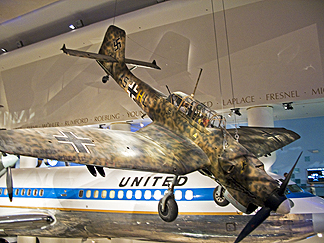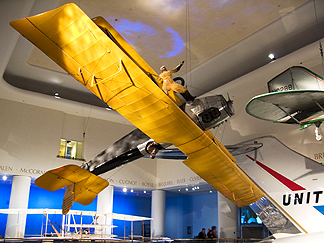 We had about 3 hours before Kris had to fly back home so we went to the Museum of Science and Industry. We ate at the museum as soon as we got there and made a plan to get through it as fast as we could. |
 Deadly accurate, German Stuka dive bombers wrought more destruction on Allied ground forces than any other aircraft during WWII. This plane was captured by the Allies on a North African airfield in 1941. It’s special camouflage, sand filter, desert survival supplies and other modifications prepared this plane for tropical combat. This is one of only two remaining Stukas in existence today. |
 This attached to an air balloon. |
 A shot of many of the planes. |
 The Spitfire. During WWII, the Supermarine Spitfire Mark 1-A was England’s greatest defense against German invasion. |
 |
 Some of these planes we didn't take pictures of the information so I don't know what they are. |
 An aerial acrobat, the Jenny, was sturdy and maneuverable - perfect for novice pilots to fly. The first mass-produced airplane, the Curtiss JN-4D “Jenny” made flying accessible to the public. The Jenny was the first airplane many Americans had ever seen and many first airplane rides were taken in Jennies. In 1933, John L. Brown flew this Jenny at Chicago’s A Century of Progress World’s Fair and donated the plane to the museum. |
 Orville and Wilbur Wright. |
 And their plane. |
 From the back. |
 Frank Hawks piloted the Travel Air Model R “Mystery Ship,” nicknamed the Texaco 13., to break more than 200 speed and distance records around the world. On August 13, 1930, Frank Hawks and his Mystery Ship broke Charles Lindbergh’s record by flying from Los Angeles to Long Island in 12 hours, 25 minutes and 3 seconds. |
|
e-mail us at kasuko@sager.org |